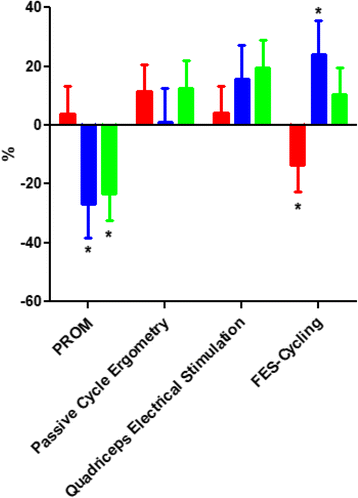Comparison of exercise intensity during four early rehabilitation techniques in sedated and ventilated patients in ICU: a randomised cross-over trial
- PMID: 29703223
- PMCID: PMC5923017
- DOI: 10.1186/s13054-018-2030-0
Comparison of exercise intensity during four early rehabilitation techniques in sedated and ventilated patients in ICU: a randomised cross-over trial
Abstract
Background: In the ICU, out-of-bed rehabilitation is often delayed and in-bed exercises are generally low-intensity. Since the majority of rehabilitation is carried out in bed, it is essential to carry out the exercises that have the highest intensity. The aim of this study was to compare the physiological effects of four common types of bed exercise in intubated, sedated patients confined to bed in the ICU, in order to determine which was the most intensive.
Methods: A randomised, single-blind, placebo-controlled crossover trial was carried out to evaluate the effects of four bed exercises (passive range of movements (PROM), passive cycle-ergometry, quadriceps electrical stimulation and functional electrical stimulation (FES) cycling) on cardiac output. Each exercise was carried out for ten minutes in ventilated, sedated patients. Cardiac output was recorded using cardiac Doppler ultrasound. The secondary aims were to evaluate right heart function and pulmonary and systemic artery pressures during the exercises, and the microcirculation of the vastus lateralis muscle.
Results: The results were analysed in 19 patients. FES cycling was the only exercise that increased cardiac output, with a mean increase of 1 L/min (15%). There was a concomitant increase in muscle oxygen uptake, suggesting that muscle work occurred. FES cycling thus constitutes an effective early rehabilitation intervention. No muscle or systemic effects were induced by the passive techniques.
Conclusion: Most bed exercises were low-intensity and induced low levels of muscle work. FES cycling was the only exercise that increased cardiac output and produced sufficient intensity of muscle work. Longer-term studies of the effect of FES cycling on functional outcomes should be carried out.
Trial registration: ClinicalTrials.gov, NCT02920684 . Registered on 30 September 2016. Prospectively registered.
Keywords: Early rehabilitation; Intensive care unit; Mechanical ventilation; Metabolism; Sedation.
Conflict of interest statement
Ethics approval and consent to participate
Ethical approval was granted by the French Comité de Protection des Personnes Nord-Ouest 3 (2016–04). All patients or their relatives provided informed consent to participate.
Competing interests
The authors declare that they have no competing interests.
Publisher’s Note
Springer Nature remains neutral with regard to jurisdictional claims in published maps and institutional affiliations.
Figures



References
Publication types
MeSH terms
Substances
Associated data
LinkOut - more resources
Full Text Sources
Other Literature Sources
Medical
Miscellaneous

